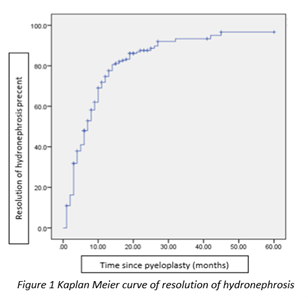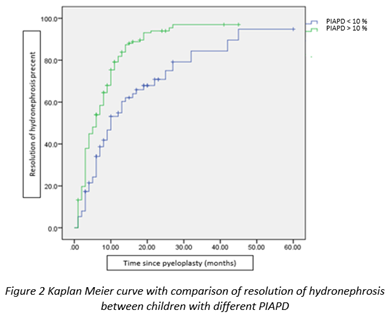Back
Poster, Podium & Video Sessions
Podium
PD48: Pediatic Urology: Genitalia, Upper & Lower Urinary Tract
PD48-08: Predictors of resolution of hydronephrosis after pyeloplasty in children. Will it go away?
Sunday, May 15, 2022
2:10 PM – 2:20 PM
Location: Room 244
Mohamed Soltan*, Ahmed Abdelhalim, Mohamed Edwan, Ahmed Elkashef, Ahmed Atwa, Mohamed Abou-El_Ghar, Tamer Helmy, Ashraf Tarek, Mohamed Dawaba, Ahmed Shokier, Mansoura, Egypt
- MS
Podium Presenter(s)
Introduction: Pyeloplasty operation entails removal of the obstruction at the pelvi-ureteric junction. However, hydronephrosis (HN) may persist despite patent anastomosis. Resolution of HN is still not well understood and time to HN resolution varies greatly among subjects. Consequently, postoperative follow up protocols are different worldwide. The objective of the study is to identify the timing of resolution of HN after successful pyeloplasty and factors predicting it.
Methods: Data of children < 15 years who underwent pyeloplasty at a tertiary center between January 2015 and October 2019 were reviewed. Patients who underwent redo pyeloplasty and those with missing data were excluded. HN resolution was defined as decrease of the antero-posterior diameter (APD) to less than 10 mm or >50% reduction of the APD. Analysis of survival using Kaplan Meier`s curve was performed with adjustment to perioperative and clinical data.
Results: A total of 256 children were included in the study. HN resolution rate was 74.6%, 87.3%, 93.7% and 97% at 1, 2, 3 and 4 years of follow-up; respectively (figure 1). Univariate analysis showed no difference in resolution neither between patients with preoperative APD <2, 2-4 and more than 4 cms (p = 0.15), between different hydronephrosis grades (p = 0.38) or between patient age groups <1, 1-5, 5-10 and >10 years old (p = 0.21). Also bilateral cases those poorly functioning kidneys ( <20% split renal function) did not show any difference in resolution of HN (p = 0.2, and 0.7 respectively). However, patients with solitary kidneys had less HN resolution rates (p = 0.03). In addition, cases with percent of improvement of APD (PIAPD) more than 10 % within the initial visit showed significantly better HN resolution rates (p=0.0001) (figure 2). Both were significant in cox regression analysis.
Conclusions: In more than 90 % of cases, HN tend to resolve within 3 years after pyeloplasty. Patients with decrease in APD more than 10 % from the preoperative value have higher rates of resolution, however patients with solitary kidney have lower rates of resolution.
Source of Funding: No


Methods: Data of children < 15 years who underwent pyeloplasty at a tertiary center between January 2015 and October 2019 were reviewed. Patients who underwent redo pyeloplasty and those with missing data were excluded. HN resolution was defined as decrease of the antero-posterior diameter (APD) to less than 10 mm or >50% reduction of the APD. Analysis of survival using Kaplan Meier`s curve was performed with adjustment to perioperative and clinical data.
Results: A total of 256 children were included in the study. HN resolution rate was 74.6%, 87.3%, 93.7% and 97% at 1, 2, 3 and 4 years of follow-up; respectively (figure 1). Univariate analysis showed no difference in resolution neither between patients with preoperative APD <2, 2-4 and more than 4 cms (p = 0.15), between different hydronephrosis grades (p = 0.38) or between patient age groups <1, 1-5, 5-10 and >10 years old (p = 0.21). Also bilateral cases those poorly functioning kidneys ( <20% split renal function) did not show any difference in resolution of HN (p = 0.2, and 0.7 respectively). However, patients with solitary kidneys had less HN resolution rates (p = 0.03). In addition, cases with percent of improvement of APD (PIAPD) more than 10 % within the initial visit showed significantly better HN resolution rates (p=0.0001) (figure 2). Both were significant in cox regression analysis.
Conclusions: In more than 90 % of cases, HN tend to resolve within 3 years after pyeloplasty. Patients with decrease in APD more than 10 % from the preoperative value have higher rates of resolution, however patients with solitary kidney have lower rates of resolution.
Source of Funding: No



.jpg)
.jpg)